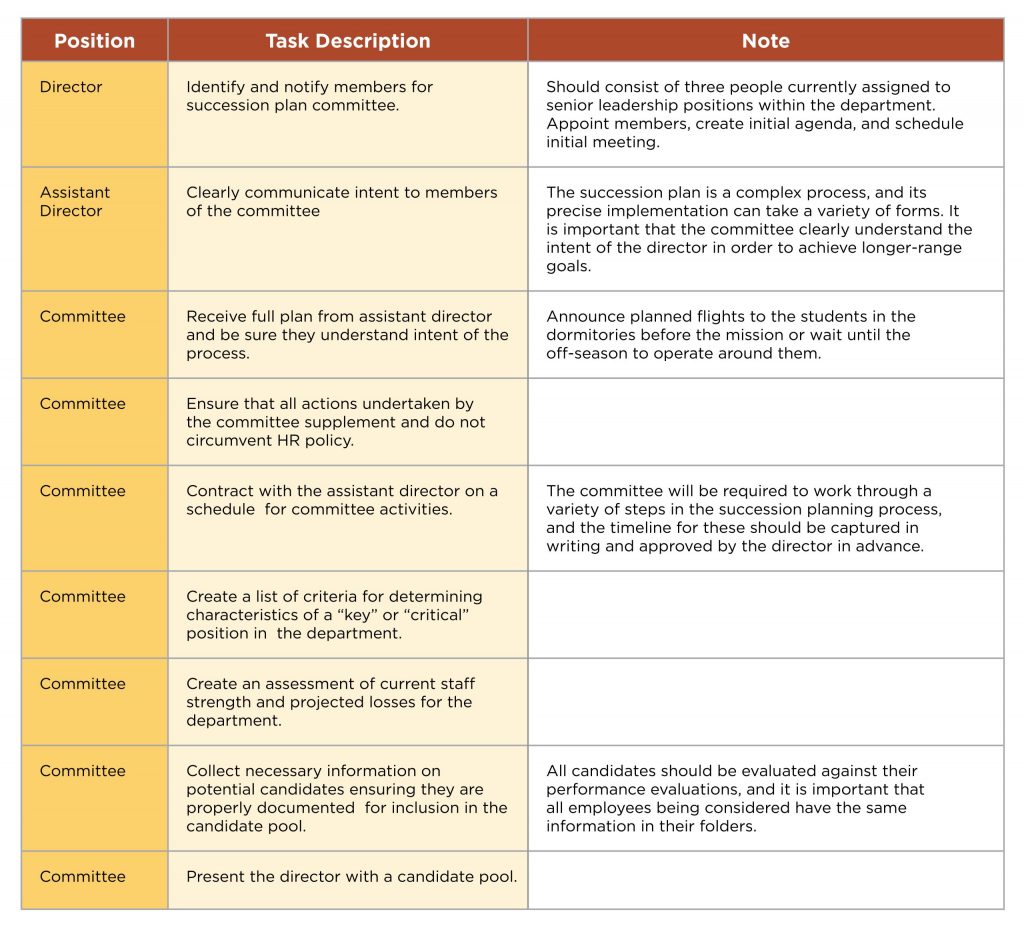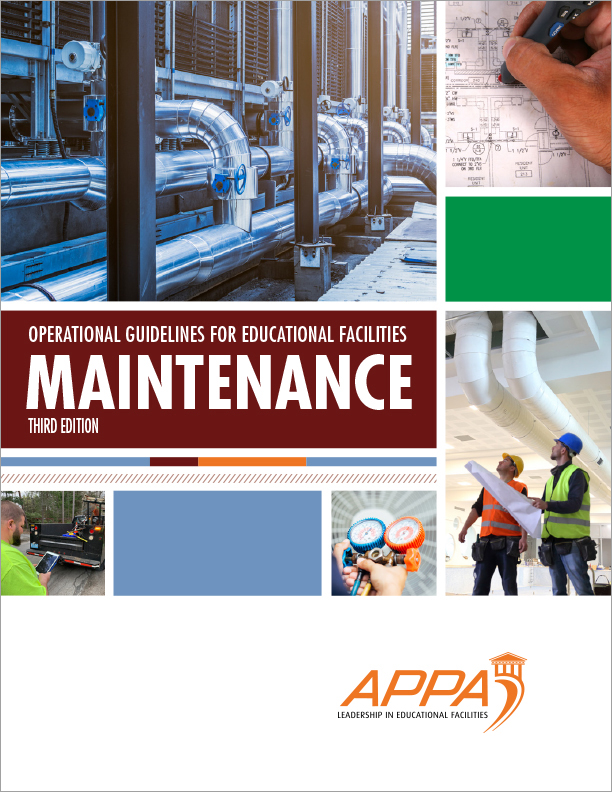Succession planning is a deliberate, continuous process in which the leader identifies key positions in the department and develops a plan for replacing staff in anticipation of loss (retirements, separations, and mandated force reductions).
The succession planning process itself is flexible. It consists of steps or phases that include assessing the need within the department, identifying critical positions and creating a candidate pool, negotiating/contracting commitment and assigning responsibilities, and assessing and developing candidate proficiency. These steps are further described below.
1. Assess the need for and support of a succession plan within the department:
The process of developing a succession plan must be built on a need within the organization. Therefore, the process of development must begin with a thorough assessment to determine whether existing procedures are adequate to the department’s staffing mission. The important point is that the leadership team must start with this analysis of the organization and look for gaps or opportunities, but with the expressed purpose of identifying those positions that are going to be referred to as key or critical to the organization and that must be accounted for in this plan.
During the assessment, the intent is to determine whether:
- There is existing consideration for an unexpected loss of key personnel within the department.
- There is an unacceptable risk if there is not a viable process in place.
- There is formal guidance from the parent organization or higher, as necessary.
There is a need for similar planning for junior leadership or project management positions as there is for managerial/professional positions (if any are identified as critical).
The assessment must consider all aspects of the department’s workforce, to include demographics, retirement eligibility, and preparedness to quickly fill key positions.
Finally, management support will be required whenever people are being positioned in the organization. Obtaining the director’s support ensures allocation of resources and provides a contract for support in effecting any future requirements.
2. Identify key or critical positions and associated competency requirements and create a viable candidate pool:
This phase requires intentional and deliberate effort on the part of leadership, because it will be easy to bypass or overlook due to a level of perceived familiarity; it is possible to assume you know the answers and not complete it thoroughly, which is a mistake. This phase must be performed completely.
This phase will evaluate and update position descriptions and will articulate the competencies currently needed for success in the identified positions.
With the positions identified and the associated competencies listed, identify all potential candidates within the organization. This action is perhaps best incorporated into the performance assessment activities of the department, if they are well developed. It is simply the process of comparing performance to stated standards with the intention of identifying employees with high potential.
This results in the creation of a collection of qualified candidates. There may be a need for continued comparison and/or development of the candidates. This is the short list or pool to focus your resources on.
3. Negotiate/obtain commitment and subsequent responsibilities:
This begins with initiating communication and consists of creating a formal process for notification of intent to the prospects and their supervisors. It includes:
- Determining employee interest and availability.
- Assigning or modifying mentoring relationships where appropriate.
- Communicating an elevated level of performance expectations.
This will also be the phase where it is most appropriate to disseminate or implement departmental policy or procedural guidance for the succession plan. Certainly, it will need to be included in the department’s standard operating procedure (SOP), but it may warrant additional guidance or instruction as a part of more formal department policy.
4. Assess and develop candidate proficiency:
This phase begins with assessing the candidates’ current skills to determine needs and then addressing your findings with a training program.
Assessing the existing skill sets consists of a skill “gap analysis” whereby future needed competencies for a key or critical position are measured against the demonstrated skill sets of the available candidates. This gap analysis measures against the future competencies necessary for success in the identified positions. The result of this step can be a bit involved. Once the gap or need is identified through the analysis, leadership must then create an effective program of training and development to bridge the gap and prepare the candidates in a timely manner. This part of the process lets you allocate resources in favor of future assignments that support your succession plan, which means that you will position the employees identified by the process to attend limited training and development opportunities first.
Continuously monitor the succession plan. Creating a succession plan for your department is not the end of the process. You must effectively implement the plan in a manner that positions employees to reduce the threat of loss in the event that a critical position is vacated. An effective plan requires leadership to determine what success will look like and then effect actions to ensure the desired result is achieved.
In summary, succession planning is an essential activity that should be integrated throughout the department’s staffing and training efforts, and it must be well developed and incorporated into the department’s SOP to provide guidance to the leadership team and to contribute to your staff’s understanding of the potential for their growth in the organization.
If done thoroughly, succession planning will identify, develop, and position your highest-performing subordinates. It will offer an identifiable goal to provide
motivation for employees, and it will reduce the damage of an unexpected loss in the department.
A succession plan is an invaluable resource management tool for any organization. In addition to the primary benefit of preparing for loss, succession planning presents these corollary benefits:
- It utilizes assessments of employee performance and contributes to planned employee development and assignment.
- It increases the leader’s familiarity with their employees’ performance and ties that knowledge to the needs of the department and others.
- It helps the leader identify the senior staff’s intent regarding professional development and is also an important tool the leader can use to request and allocate discretionary resources (i.e., training dollars).
There are a variety of tools and references available when developing a succession plan. The process can be professionally guided, a packaged program can be purchased, or it can be done in-house. Which method is best depends on the resources and capa bilities of the organization. While this process is like other leadership/management processes in that handling it in-house usually provides the most benefit, that reward is compounded many times with succession planning, as it can be an introspective process for the department, involving employee assessment, development, and assignment.
Succession Plan Policy Example
Purpose
Department leadership must prepare for personnel losses in critical positions and take action to reduce or eliminate the impact of these losses. This succession plan applies to the department when identifying employees with the potential to fill vacated leadership positions either in the interim or, in the case of lead positions and other positions not restricted by higher agencies, to be selected for full-time assignment to the position.
The university has an established process for the formal replacement of managerial/professional positions that is proctored by HR. This department succession plan will not circumvent that process or result in any activities or appointments that interfere or conflict with the university’s policies. Rather, it will initiate a focused assessment of key positions and of employee performance. It will result in the creation of a pool of employees whose demonstrated potential provides them the opportunity for increased training and mentoring in order to enhance their ability to occupy one of these key positions and contribute to the continued success of the department.
Succession planning is management of our human resources, and it is intended to ensure that a replacement is in line, trained, and qualified to step into a vacated position.
Process
The process is owned by the director of the department and is managed by the assistant director of operations.
The assistant director will assign a committee to execute the succession plan. This succession planning committee will consist of three members from senior leadership positions in the department and will be responsible for completing the processes and producing a considered candidate pool to present to the director for each identified critical position.
The process of succession planning will include:
1. Director appoints committee members (to be rotated alternately each year, ensuring no two members are new in a given year) and convenes initial meetings to review the succession plan’s intent, timeline and intermediate requirements, and sequence of events.
2. The committee identifies critical positions. To do so, the committee:
a. develops criteria for identifying essential positions and measures likely positions against these criteria.
b. measures the initial list of essential positions against current strength criteria to determine whether any of the positions have an additional element of anticipated, routine vacancy upcoming.
c. develops a final list of positions in the department that are key or critical to be continuously staffed in the department.
i. whether the position is listed only as one with potential for unexpected loss or whether any position also has the element of an anticipated future loss such as retirement.
ii. whether each identified position is a managerial/professional position, thereby restricting the succession plan’s final actions to recommending an interim staffing assignment.
iii. whether each of the identified positions is a service/trade position, thereby granting the succession plan full latitude to recommend a permanent staffing assignment.
3. The committee compiles performance evaluations and supervisor input to create an initial candidate pool. They then compare the skills of the individual candidates to the requirements of each position and conduct a gap analysis to validate the pool and to identify and provide training and development needs.
4. On the director’s approval of the candidate pool, the assistant director meets with the candidates to determine their acceptance and to enroll them in the program.
5. The committee will follow up on progress of the training program’s ability to prepare the candidates for succession into the identified leadership positions.
Succession Plan Responsibility Matrix

Bob Beckstrom is manager of administrative services at the University of Nebraska–Lincoln; he can be reached at [email protected]. This is his first article for Facilities Manager.
This article is excerpted from the Staff Development, Hiring, and Training chapter in the forthcoming APPA publication, Operational Guidelines for Educational Facilities: Maintenance, available from the APPA Bookstore at https://www.appa.org/bookstore/.




